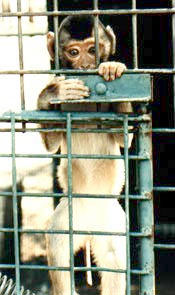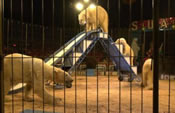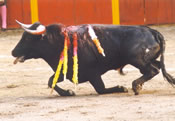
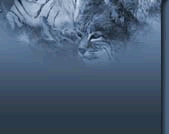
| The
Circus Slave
By Christina Sharik
I am the circus elephant |
Animals Used as Entertainment
As a child one is naturally fascinated by animals . Every opportunity we got to see an animal was rejoiced. We ignored the atrocities that were behind the curtains, we were not told the other side of the story. But now that we are not children any amore, we can see what is behind the curtain. It is not a pretty picture and we don't have to sit the entire show to watch it. We can turn it off. STOP ANIMAL EXPLOITATION. TAKE THE CURTAINS OFF. SEE WHAT IS IN THE OTHER SIDE AND DO SOMETHING ABOUT IT.
Circuses, zoos, bullfights, horse racing, carriage horses, cock fights, rodeos are all forms of animal entertainment. We light-heartedly call it amusement or sport, but for the animals, it is a pathetic life filled with deprivation, stress, cruelty, confinement, terror, loneliness, and boredom.
Circuses
|
The standard training method for animals in the circuses has always been physical punishment. In order to maintain control over the animals, trainers must break their spirit and make them fearful. Some animals are drugged to make them "manageable," they are also whipped, choked, and beaten during training sessions and some have their teeth removed. Similarly, the tricks that animals are forced to perform in circuses are physically uncomfortable and behaviorally unnatural. Whips, muzzles, electric prods, collars, bullhooks, and other tools used on animals during circus acts are reminders that the animals are being forced to perform. Furthermore, the transportation and the living condition of animals in circuses is also a living nightmare. Most of the animals are large and are confined to spend most of their lives in the small cages used to transport them, and they are allowed out of their cages only for the short periods when they must perform. Plus climatically, the circus environment is quite different from the animals' natural habitats. The hot summer months can be especially hard on animals like bears, while others, like lions, suffer most from the cold. After the animals
have outlived their performing "usefulness," they are
either permanently relegated to winter quarters (often cages)
or are sold to other circuses, zoos, private menageries, game
farms (to be shot for "recreation" or for "exotic"
meat), or even research laboratories. They often end their lives
no more peacefully or comfortably than they lived them: in confinement,
coercion, and misery (PETA). |
Zoos
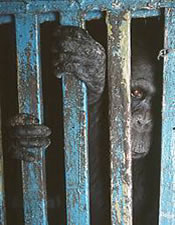 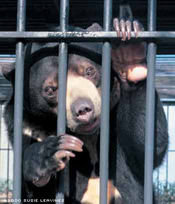
|
Despite the fact that zoos profess to educate and preserve various animal species, they often fall quite short on both counts. Most visitors to zoos spend only a few minutes at each cage, seeking entertainment rather than education. Most zoo enclosures are quite small, and labels provide little more information than the species' name, diet, and natural range. The animals' normal behavior is seldom discussed, much less observed, because their natural needs are seldom met. Birds' wings may be clipped so they cannot fly, aquatic animals often have little water, and the many animals who naturally live in large herds or family groups are often kept alone or, at most, in pairs. Natural hunting and mating behaviors are virtually eliminated by regulated feeding and breeding regimens. The animals are closely confined, lack privacy, and have little opportunity for mental stimulation or physical exercise, resulting in abnormal and self-destructive behavior, called zoochosis. Zoos remain now, as always more a "collection" of interesting items rather than actual havens or simulated habitats. Zoos teach people, and more often than not children, that it is acceptable to keep animals imprisoned, bored, cramped, and lonely and far from their natural homes (PETA). |
Rodeos
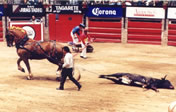 |
Rodeos are promoted as rough and tough exercises of human skill and courage in conquering the fierce, untamed beasts of the Wild West. In reality, rodeos are nothing more than manipulative displays of human domination over animals, thinly disguised as entertainment. What began in the late 1800s as a skill contest among cowboys has become a show motivated by greed and profit. Typical rodeo events include calf roping, steer wrestling, bareback horse and bull riding, saddle bronco riding and steer roping. The animals used in rodeos are captive performers. Because of the harsh treatment they receive, they are understandably distrustful of humans. Most rodeo animals are not aggressive by nature, but are provoked into exhibiting "wild" behavior in order to make the cowboys look brave. Electric rods, sharp sticks and other tortuous devices are used to enrage and iritate rodeo animals. The "bucking" strap used to make horses and bulls buck is tightly cinched around their abdomens, where there is no rib cage protection. The belt pinches the groin and genitals and causes the animal to buck, which is what rodeo promoters want in order to put on a "good show". The final destination of these animals is often the slaughter house (Free all Animals). |
Bullfighting
|
|
At
best, the term "bullfighting" is a misnomer, as there
is usually little competition between the sword of a nimble matador
(Spanish for "killer") and a confused, maimed, psychologically
tormented, and physically debilitated bull. Supporters justify
the act by calling it a tradition. Opponents maintain that no
matter what the history, bullfighting is torturous animal mutilation
and slaughter. People who support
this absurd and cruel tradition say that is a way of art that
clearly shows that men are better than beast. If this was the
truth we have to remind these supporters that the fight is not
a fair and equal fight. Bulls are routinely debilitated with tranquilizing
drugs and laxatives, have heavy weights hung around their necks
for weeks before the fight, endure beatings to the kidneys, have
petroleum jelly rubbed into their eyes to blur vision, and are
confined to darkness for hours before being released into the
bright arena. Additionally, bulls are not the only victims in the ring. Horses used in bullfights are also victimized. Blindfolded so they cannot run away, the horses are used to draw the terrified and confused bull into an attack. Two men on horseback repeatedly spear the bull, while the horse takes the punishment. Although they are wrapped in padding, horses are regularly injured and killed in bullrings (Free the Animals). |
Cockfighting
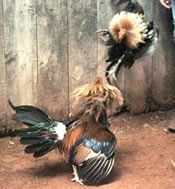 |
Roosters
raised for fighting are often confined to tiny cages and tormented
to make them aggressive. Cockfighters feed “gamecocks”
a steady diet of stimulants and blood clotting drugs and attach
razor sharp spurs to the birds’ feet to make fights more “exciting”
(i.e., bloody). The birds suffer broken wings and legs, punctured
lungs, severed spinal cords, and gouged out eyes. The “lucky”
ones die; the survivors are fought again. There is no “victory”
for fighting cocks. Cockfighting is illegal in all but 3 U.S. States - Louisiana, New Mexico (where it is banned in 9 counties and 20 municipalities), and Oklahoma. In the majority of American States, cockfighting has been banned for more than 100 years. In 19 states, cockfighting is a felony offense, and in 33 states it is against the law merely to watch a cockfight. Making the practice illegal significantly reduces the number of birds that are killed. While some cockfighting still takes place in states where it is banned, making it illegal shuts down the large established cockfighting pits that kill up to 1,000 birds in one weekend event (PETA). |
Horse Racing
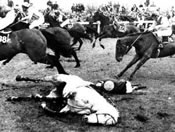 |
Drug abuse, injuries to horses, race fixing, organized crime, and declining public interest have all become integral to the horse racing industry. The industry's whips and blinders are visible reminders that horse racing is merely another form of animal exploitation. Racehorses have
a drug problem; many have been turned into junkies by their trainers
and even by veterinarians, who frequently provide drugs to keep
horses on the track even when they shouldn't be racing. Commonly
used drugs such as Lasix (furosemide) and Bute (phenylbutazone)
relieve symptoms like pain and bleeding but don't treat the underlying
disorders. Horses are forced to race with hairline fractures that
would, without drugs, be too painful to run on. As a result, injuries
and chronic lameness are common. Horses who fail to bring in winnings
are rarely rewarded with an easy retirement; more likely, they
will suffer an unceremonious early death, and their flesh will
be sold overseas for human consumption or rendered into dog food
or glue. |
Carriage Horses
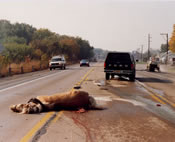 |
Every year, hundreds of carriage horses in the United States and around the world are used, abused, and then slaughtered. That is of course, if they are not killed on the streets first. According to the Carriage Horse Action Committee, the average working life of a carriage horse in New York City is less than four years. As much as the operators of horse and carriage operations would like us to believe that their trade is "romantic", it is anything but that in today's crowded cities. Horses are made to work long hours in all types of weather, battle traffic, breathe exhaust fumes from buses, trucks and cars. In general, horses are not adequately watered, since the sight of a horse urinating is "bad for business". Lameness and hoof deterioration are inevitable consequences of a life spent unnaturally walking and jogging on the asphalt of city streets. In New York City, we enjoy the dubious distinction of having the highest carriage horse accident rate in the country. Carriage horse accidents occur in every city that allows this cruel trade to continue. Weather conditions also play a huge role. In 1994, two horses died within a 16 day period of hot summer weather. Another year, three horses died on the same day, followed by a fourth shortly afterwards. The good news is that more and more people are refusing to patronize this cruel trade. In fact, pressure from concerned residents has resulted in bans on carriage horses in a number of cities, including Palm Beach, Florida; Santa Fe, New Mexico; Las Vegas, Nevada; London; Paris and Toronto (PETA). |
What Can You Do
* Eliminating animal exploitation simply means the increased use of human performers. Write to PETA for information on ways to get an animal display ban passed in your area.
* Don't patronize circuses that use animals. PETA can provide "Circus Check" fliers to pass out to patrons if the circus comes to your town. Find out about state and local animal protection laws, and report any possible violations to authorities.
* Take your family to see only animal-free circuses, such as the Cirque du Soleil or the Pickle Family Circus
* Zoos are covered under the federal Animal Welfare Act (AWA), which sets minimal housing and maintenance standards for captive animals. The AWA requires that all animal displays be licensed with the U.S. Department of Agriculture, which must inspect zoos once a year. However, some zoos that have passed USDA inspections with flying colors have later been found by humane groups to have numerous violations. Educate yourself. Read Beyond the Bars, edited by Virginia McKenna, Will Travers, and Jonathan Wray. It is available from Thorson's Publishing Group in Rochester, Vt.
* It is best not to patronize a zoo unless you are actively working to change its conditions. Avoid smaller, roadside zoos at all costs. If no one visits these substandard operations, they will be forced to close down.
* Start a "Zoocheck" program to build a strong case for implementing changes: Contact PETA for Zoocheck program materials and information on how to get started with your local zoo.
If you are planning to visit a country that permits bullfighting, please tell your travel agent that you are opposed to animal cruelty in any form. Many tourist resorts are building bullfight arenas as part of their "recreation" facilities; refuse to stay at such a resort, and write a letter to the owner explaining why. Instead, visit the Spanish resort towns that have banned bullfighting: Tossa de Mar, Vilamacolum, and La Vajol. In Mexico, the city of Jalapa has also banned bullfighting.
• Before you go on vacation abroad, write to the country’s ambassador and ask whether rituals involving animal slaughter are part of its tourist attractions. Make it clear that you want no part of such activities, and never be afraid to talk about bullfighting cruelties. Most people are unaware of the facts but agree that bullfighting should be stopped once they hear the whole story.
• Please write to the Spanish and Mexican embassies and explain that as long as this cruel bloodsport continues, you will never visit their countries.
Embassy of Spain
2375 Pennsylvania Ave. N.W.
Washington, DC 20037
Embassy of Mexico
1911 Pennsylvania Ave.
Washington, DC 20006
* If a rodeo comes to your town, protest to local authorities, write letters to sponsors, leaflet at the gate, or hold a demonstration.
* Do not support any kind of animal entertainment even though it sounds a lot of fun remember that our friends the animals are not enjoying the ride or the show like you and are victims of torture.

Voice For All Animals,500 West University Ave.,P.O. Box 452.El Paso TX 79968-9991
